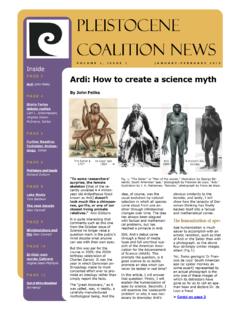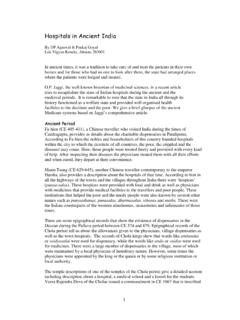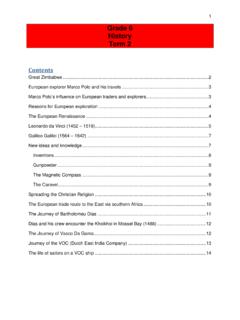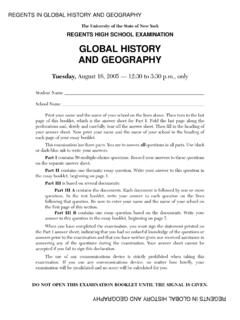Transcription of Pleistocene coalition news V O L U M E 8 , I S S U E 1 J A ...
1 BUSINESS NA MEBUSINESS NA MEBUSINESS NA MEBUSINESS NA ME Pleistocene coalition news J A N U A R Y - F E B R U A R Y 2 0 1 6 V O L U M E 8 , I S S U E 1 Inside P A GE 2 The Valsequillo/Hueyatlaco story: Overview and links Virginia Steen-McIntyre P A GE 5 Petroglyphic rock art in Delhi, India Raghubir S. Thakur P A GE 8 Member news and other information Virginia Steen-McIntyre, Fred E. Budinger Jr, Marilyn Jesmain, John Feliks P A GE 10 How three countries are treating their early man sites John Feliks P A GE 11 Reviving the Calico of Louis Leakey, : Audio clips John Feliks P A GE 12 Marija Gimbutas: 1921 1994 Marilyn Jessmain P A GE 14 A lithic site at West Runton, Norfolk Kevin Lynch and Richard Dullum P A GE 16 Pleistocene under-ground, Part 2 Vesna Tenodi - C h a l l e n g i n g t h e t e n e t s of m a i n st re a m sc i e n t i f i c ag e n d a s - SPECIAL LINKS FEATURE: Valsequillo story 50th Anniversary Standing up for truth in science no matter what the consequences is what it s all about.
2 2016 marks the 50th Anniver-sary since Pleistocene coalition founding member, Dr. Virginia Steen-McIntyre (volcanic ash specialist), began her work with the long-suppressed evidence from the Hueyatlaco early man site excavations in Mexico in 1966. She has stuck to her guns. Virginia was part of a team of pro-fessional geologists and chemists from the Geological Survey (USGS) whose various dating methods (uranium series, fission-track, glass hydration, mineral etching) produced dates of c. 250,000 years. Later re-testing con-firmed the old dates as did new dating by leading diatomist, Sam L. VanLandingham. Learn the story of how objective scientists lacking a necessary outcome based on ide-ology had no problems with their dates. The only problems and they were immediate came from those in anthropology and archae-ology steered by preconceived expectations that the dates were too old for the Americas ( ).
3 Virginia Steen-McIntyre, PhD, provides direct links to her Valsequillo Saga series marking her 50th anni-versary of fight-ing for truth in science publica-tion ( ). Archaeologist Marilyn Jesmain, PhD, provides a bio of the fasci-nating and controversial archaeologist the late Dr. Marija Gimbu-tas. Whatever one may think of Gimbutas ideas her work was highly influ-ential creating a niche between archaeological interpretation and mythology( ). Archaeologist, Fred E. Budinger Jr., disturbing news on what is being done to Calico Early Man Site (p. 9). Getting prehistory back into the hands of objective researchers the team of Lynch and Dullum con-tinue to set high standards. Here, they further demonstrate the value of emulating amateur scientists who beat the mainstream at their own game 100 years ago (p. 14).
4 It would be useful Why not? from time to time, and to rethink all we believe we know. Vesna Tenodi, Pleistocene under-ground, Prt 2( p. 16) Comparing how three countries Germany, the United States, and Mexico are treating their early man sites. jf ( ) Raghubir S. Thakur, MA History (former Consultant Security and Land Management, Archaeological Survey of India ASI) studying the oldest rock art for over 20 years provides an introduction to his discoveries and extensive GPS catalogue of ancient rock art in Delhi region (p. 5). Audio excerpts from Dr. Louis Leakey s 1970 Cal-ico talk. When pro-moting standard evolutionism Leakey was praised the world over. Ridicule began when he followed the evi-dence and started promoting early man in the Ameri-cas more proof anthropology is agenda-driven. John Feliks (p.)
5 11). P A G E 2 V O L U M E 8 , I S S U E 1 P L E I S T O C E N E C O A L I T I O N N E W S written by the then still-living scientists involved, here is the link to the online version: The stratigraphic debate at Hueyatlaco, Valsequillo, Mexico. Palaeontologia Electronica 14 (3), Nov. 2011. Here is the link to the download-able PDF (28 MB): Malde, EH, V Steen-McIntyre, CW Naeser, and SL VanLandingham. 2011. The stratigraphic debate at Hueyatlaco, Valsequillo, Mexico. Palaeontologia Electronica 14 (3), pp. 1-26. ] For PC founding member, Chris Hardaker's 2007 take on the story, see his book The First American: the suppressed story of the people who discovered the New World. _____ Detailed history Below is the history of my involvement with the Hueyat-laco/Valsequillo saga as given in PCN with direct links to the arti-cles.
6 For those not yet familiar with Hueyatlaco and Valse-quillo, they represent middle Pleisto-cene-age sites in North America where advanced tools, engravings, and other signs of intelligent early people have been discov-ered and, as such, have made them the bane of mainstream 2016 marks the 50th an-niversary of my first in-volvement with the Valse-quillo early man archaeological sites (Fig. 1), State of Puebla, Mexico. Who could have pre-dicted that the project would essentially control the rest of my professional life! Or that I would end up as a black-sheep scientist be-cause of it! In the last issue of this newsletter (Issue 38), editor John Feliks presented an overview, including links, of his many articles to date debunking evolutionary propaganda. He suggested I do something similar for my reminiscences of The Valse-quillo Saga.
7 Actually, arti-cles on the subject by myself and several other authors are sprinkled throughout Pleistocene coalition News beginning with Issue 1; but they are concentrated in a series of pieces from Issues April-May to November-December of 2011. They begin when we learned that the Hueyatlaco site, at least the upper part, was no more; it had been leveled by heavy equipment and a large house and park built atop it. _____ A few external links For a popular video of the saga produced by Emmy-winning filmmaker, Bill Cote (Mystery of the Sphinx), see SUPPRESSED: New Evidence of Early Man. The film, drawing attention to scien-tific suppression, presently has well over a million views. For our comprehensive 2011 scientific paper on Hueyatlaco American archaeology (Fig. 2). As mentioned in the opening paragraph of PCN #11 (May-June 2011), my contributions are part of the larger story of the geologists and chem-ists including the Geo-logical Survey team (USGS) and other professionals who produced similar results confirming a c.
8 250,000-year old date of for Hueyatlaco. _____ The Hueyatlaco/Valsequillo saga It begins (PCN Issue #10, March-April 2011, page 3) We at PC learn of the destruction of Hueyatlaco. Introduction (Issue 11, May-June 2011: 4 5) Part 1 (Issue 11, May-June 2011: 15 17) Part 2 (Issue 11, May-June 2011:17 20) Parts 1 & 2 tell of my introduction to the pro-ject, mar-riage, and move to Puerto Rico. Barney Szabo s ura-nium series dating method My con-tributions are part of the lar-ger story of the ge-ologists and chem-ists including the Geological Survey team (USGS) and other pro-fessionals who pro-duced simi-lar results confirming a c. 250,000-year old date for Hueyat-laco. The Valsequillo/Hueyatlaco story Overview and links By Virginia Steen-McIntyre, PhD, Volcanic ash specialist > Cont. on page 3 Fig. 2. The only artifact of archaeolo-gist Cynthia Irwin-Williams Valsequillo artifacts and fossils the location of which is known.
9 It is a bifacial spear-head which after having been lost was re-discovered in 2003. It was found unlabeled in a case of common Paleo-Indian artifacts at the National Museum of Anthropology in Mexico city. Fig. 1. JL Lorenzo Hueyat-laco excavation, c. 1966. P A G E 3 V O L U M E 8 , I S S U E 1 P L E I S T O C E N E C O A L I T I O N N E W S field data into print contin-ues. When finally published in Quaternary Research (1981) it elicits no response from the establishment. Work on evaluating the geo-logical components of the scribed Flagstaff stone. Care giving relatives. Part 4 also covers the time in which Cynthia Irwin-Williams, Juan Armenta, Jos Lorenzo, Scotty MacNeish, George Agogino, and Marie Wormington die. Michael Cremo s and Richard Thomp-son s book, Forbidden Arche-places the Valsequillog sites at roughly a quarter-million years.
10 I describe my inability to correlate the volcanic ash layers at the Hueyatlaco site with dated layers on a nearby vol-cano. Details of the 1973 field season are given as they relate to Hal Malde, myself, and geologist and archaeologist, Roald Fryxell. Part 3 (Issue 12, July-August 2011: 4 5 & 17) Part 3 in-cludes my years at the USGS (United States Geo-logical Survey) where I de-veloped my methods for rough-dating volcanic ash (tephra) from the Valsequillo sites and other sites. Chuck Naeser s fission track dating method placed tephra samples from Hueyatlaco in ap-proximate agreement with Szabo s uranium series dates. News release of the very old dates from the Valsequillo sites marked the beginning of isolation from my peers. Also covered are my New Zealand trip, the death of Roald Fryxell, and the difficulty of getting information from our 1973 field work into print, as well as work in El Salvador and production of the Hueyat-laco stratigraphic monoliths (Fig.)











